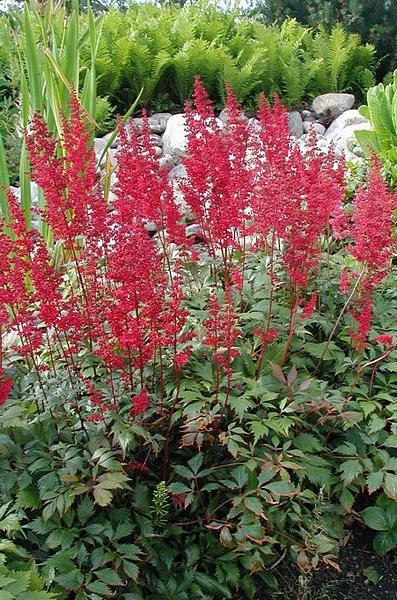Astilba is a popular perennial that blooms from early summer to mid-summer. Inflorescences in the form of panicles have a variety of colors - from white and light pink to dark red and purple. The wild species of astilbe have only two species, which are found in the Far East of Russia, in East Asia and North America. The plant is extremely cold resistant. Cultivated astilbe, whose varieties can tolerate very cold winters, took over this property from its wild relative. The name of this beautiful perennial was derived from Greek words that mean "lack of brilliance."
Astilba: plant varieties
Perennial inflorescences have a different shape - pyramids, rhombuses or panicles. The drooping bunches of flowers look very elegant. In addition, they have different densities. The denser the inflorescences, the more attractive and decorative the astilbe looks. Varieties are most often monophonic, but there are also those in which there are simultaneously several colors and shades on the same bush (Montgomery, White Wings and others). In accordance with the structure of inflorescences, the species of this perennial are divided into several groups - pyramidal, rhombic and paniculate.

The flowering periods of different varieties are also different. There are early varieties of astilbe (bloom until early July), medium (bloom in mid-summer) and late (from late August to late September). All of them are resistant to cold, disease, pests and waterlogging of soils. Illumination is the main thing astilbe is sensitive to. Varieties obtained by selection did not cease to love the constant rarefied sun's rays, as well as their wild relatives. The open sun is also not an obstacle to growth. But a thick shadow can interfere with abundant flowering.
We briefly list the main varieties. Arends hybrids are obtained from the astilbe of David, they have very tall bushes and dark leaves. Hybrid astilbe are most often characterized by a drooping form of inflorescences (a variety called “Straussenfedder”). Japanese - very short, but powerful. Good for group compositions and alpine slides. Lemoine hybrids are named after their creator; there are about twenty varieties of them.
Astilba cultivation: features
The most important thing for a gardener who decided to cultivate this plant is to exclude the possibility of long-term drought. Watering twice a day will provide maximum moisture. Fertile soil will contribute to the formation of a dense and beautiful bush. It is advisable to sprinkle the upper part of the rhizome with sawdust - this will prevent this area from drying out and overheating. The astilbe is planted in pits up to thirty centimeters wide. It is advisable to add mineral fertilizers, bone meal or ash to the hole. It does not hurt and a little humus. Astilbe have a high resistance to transplants. Even if this is done during flowering, the plant will not be harmed. Thanks to this property, you can buy a flowering astilbe on the horticultural market - this will help to avoid misunderstandings with the definition of the variety.